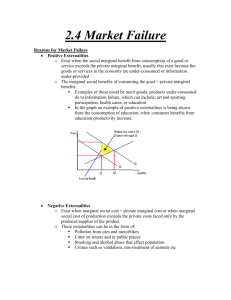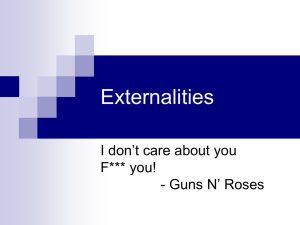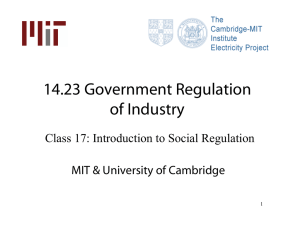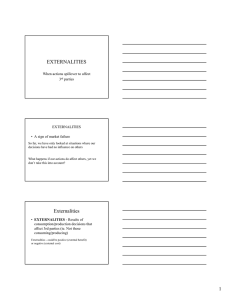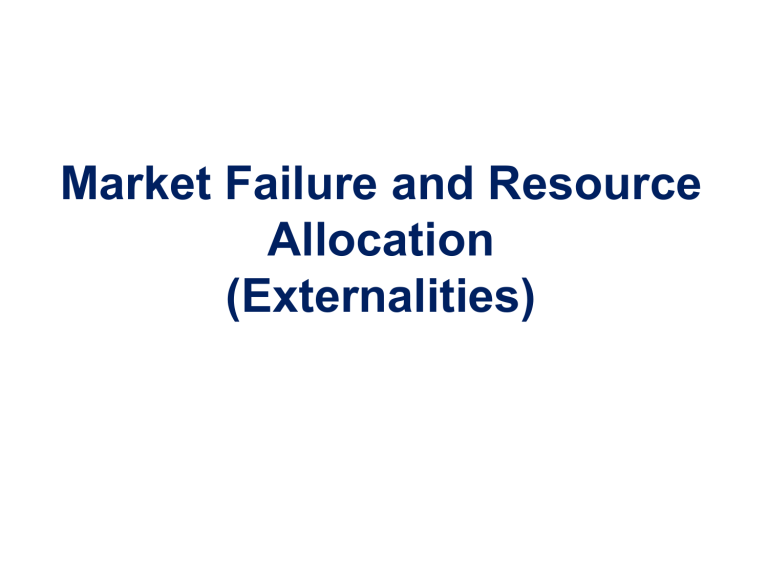
Market Failure and Resource Allocation (Externalities) 1 Market failure – What do we mean by market failure? – Just that the market fails to arrive at the “correct” price and quantity – Something is interfering with the guiding function of prices. – The most common form of market failure is externalities. – Today we are going to explore how externalities stop market achieving an allocatively efficient equilibrium 2 Externalities – An externality is a cost or benefit that arises from production and falls on someone other than the producer, or a cost or benefit that arises from consumption and falls on someone other than the consumer. – A negative externality imposes an external cost and a positive externality creates an external benefit. 3 Externalities • The four possible types of externality are: – Negative production externalities – Positive production externalities – Negative consumption externalities (not discussed) – Positive consumption externalities (not discussed) 4 Externalities • Negative Production Externalities – Negative production externalities are common. – Examples are noise from aircraft, logging and clearing of forests, and pollution – There is an incentive for firms to produce negative externalities, correcting externalities adds to costs and reduces profits. – Pollution lowers costs and increases profits. 5 Externalities • Positive Production Externalities – Positive production externalities are less common than negative externalities. – Example: a beekeeper locates beehives in an orange-growing area, the bees primary purpose is to collect nectar to make honey, but they also assist in pollination so increase the productivity of orchards and vineyards. – This increase production and profits for the farmers. 6 Externalities • Negative Consumption Externalities – Negative consumption externalities are a common part of everyday life. – Smoking in a confined space poses a health risk to others; noisy parties or loud car stereos disturb others. 7 Externalities • Positive Consumption Externalities – Positive consumption externalities are also common. – When you get a flu vaccination, everyone you come into contact with benefits. – When the owner of an historic building restores it the value of nearby houses increase, so house prices and rents rise. 8 Negative Externalities: Pollution • Private Costs and Social Costs – A private cost of production is a cost that is borne by the producer, and marginal private cost (MC) is the private cost of producing one more unit of a good or service. – An external cost of production is a cost that is not borne by the producer but is borne by others. – Marginal external cost is the cost of producing one more unit of a good or service that falls on people other than the producer. 9 Negative Externalities: Pollution • Private Costs and Social Costs – Marginal social cost (MSC) is the marginal cost incurred by the entire society and is the sum of marginal private cost and marginal external cost. MSC = MC + Marginal external cost. – Marginal private cost, marginal external cost, and marginal social cost increase with output. 10 An External Cost Cost ( dollars per tonne) 300 Marginal Social cost Figure 16.2 MSC 225 Marginal External cost 150 MC 100 75 Marginal Private cost 2 4 6 Quantity (thousands of tonnes per month) 11 Negative Externalities: Pollution • Production and Pollution: How Much? – In an unregulated market with an externality, the pollution created depends on the market equilibrium price and quantity of the good produced. – But P<P* and Q>Q* so too many resources are allocated to production. 12 Inefficiency with an External Cost Price and cost ( dollars per tonne) 300 Marginal Social cost Figure 16.3 MSC 225 Deadweight loss Efficient equilibrium Inefficient Market equilibrium 150 S= MC 100 75 D=MSB Efficient quantity Marginal Social Benefit 2 4 6 Quantity (thousands of tonnes per month) 13 Correcting Negative Externalities: • Two major approaches • Command and control policies • Market intervention 14 Correcting Negative Externalities • Command and control policies • These usually take the form of regulations that – – forbid certain behaviours require certain behaviours. • Examples: – Regulations on pollution emission levels • Internalise the externality, force the polluter to either not pollute or not discharge pollution. 15 Internalising externalities lead to an Efficient Outcome Price and cost ( dollars per tonne) 300 Price equals marginal social cost and MSB S = MC =MSC 225 Cost of pollution Borne by polluter Efficient market equilibrium MC excluding pollution cost 150 100 75 D=MSB 2 4 6 Quantity (thousands of tonnes per month) 16 Negative Externalities: Pollution • The Coase Theorem – The Coase theorem is a proposition that if property rights exist, if only a small number of parties are involved, and if transactions costs (defined below) are low, then private transactions are efficient. – There are no externalities because all parties take into account the externalities involved. The outcome is independent of who has the property rights. 17 Negative Externalities: Pollution • Transactions costs are the opportunity cost of conducting a transaction. – Example: the transactions costs of buying a home include fees for a real estate agent, and the legal cost associated with the transfer. – When a large number of people are involved then the transactions costs tend to be high, the Coase solution is not available. 18 – Also if people cannot be compensated for the effects of the pollution, then the Coase solution will not work, so-called corner solution, Coase theorem will not work. – The parties need to be negotiating in good faith, if not then no agreement will be met or transaction costs are higher. – Information asymmetry, the costs of disclosure may increase transaction costs. 19 Negative Externalities: Pollution • Taxes – The government can set a tax equal to the marginal external cost. – The effect of such a tax is to make marginal private cost plus the tax equal to marginal social cost: MC + Tax = MSC. – This tax is called Pigovian Tax, in honour of the British economist Arthur Cecil Pigou, who first proposed dealing with externalities in this fashion. 20 A Pollution Tax (ad valorum) Price and cost ( dollars per tonne) 300 Marginal social cost and MSB S = MC + tax = MSC 225 Pollution tax Efficient market equilibrium 150 MC 88 75 D=MSB Tax revenue 2 4 6 Quantity (thousands of tonnes per month) 21 A Pollution Tax (per unit) Price and cost ( dollars per tonne) 300 Marginal social cost and MSB S = MC + tax = MSC 225 Pollution tax Efficient market equilibrium 150 MC 88 75 D=MSB Tax revenue 2 4 6 Quantity (thousands of tonnes per month) 22 An example • Cigarette taxws 23 An example • Tax on alcopops 24 Positive Externalities: Knowledge • Private Benefits and Social Benefits – A private benefit is a benefit that the consumer of a good or service receives. Marginal private benefit (MB) is the private benefit from consuming one more unit of a good or service. – An external benefit is a benefit that someone other than the consumer receives. Marginal external benefit is the benefit from consuming one more unit of a good or service that people other than the consumer enjoy. 25 Positive Externalities: Knowledge – Marginal social benefit is the marginal benefit enjoyed by the entire society and is the sum of marginal private benefit and marginal external benefit. That is: – MSB = MB + Marginal external benefit. 26 Correcting Positive Externalities: Knowledge • Government Action in the Face of External Benefits – There are three main methods that the government uses to cope with external benefits: Public provision Private subsidies Vouchers 29 Correcting Positive Externalities: Knowledge • Three possible goals of policy • First get both P and Q correct. • Second get Q correct and not worry about P being wrong. • Third get P correct and not worry about Q being wrong. 30 Correcting Positive Externalities: Knowledge • Public Provision – Under public provision, a public authority that receives its revenue from the government produces the good or service. – Education services produced by the public universities and schools are examples of public provision 31 Positive Externalities: Knowledge • Private Subsidies – A subsidy is a payment by the government to private producers. The government can induce private decision makers to consider external benefits by making the subsidy depend on the level of output – If the government pays the producer an amount equal to the marginal external benefit for each unit produced, the quantity produced increases to that at which marginal cost equals marginal social 33 benefit—an efficient outcome. Positive Externalities: Knowledge • Vouchers – – A voucher is a token that the government provides to households, which can be used to buy specified goods or services. A school voucher allows parents to choose the school their children will attend and to use the voucher to pay part of the cost. The school cashes the voucher to pay its bills. 35 An example • The triangle waistshirt company 37



